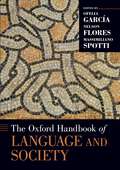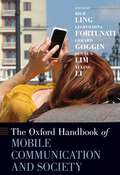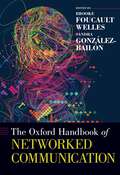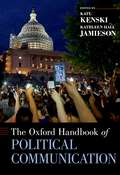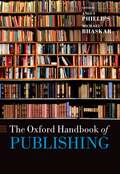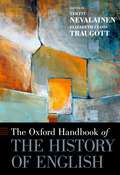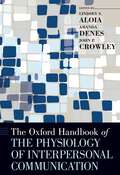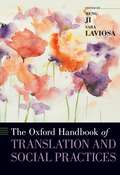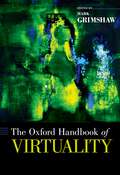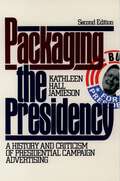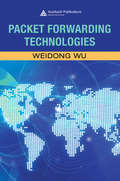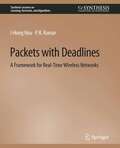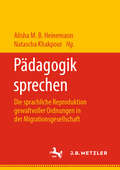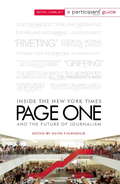- Table View
- List View
The Oxford Handbook of Language and Society (Oxford Handbooks)
This Oxford Handbook challenges basic concepts that have informed the study of sociolinguistics since its inception in the 1960s. In 27 chapters, the book challenges the modernist positivist perspective of the field that has treated languages and speech communities as bounded and the idealized native speaker as the ultimate authority. Instead, it offers a critical poststructuralist perspective that examines the socio-historical context that led to the emergence of dominant sociolinguistic concepts and develops new theoretical and methodological tools that challenge these dominant concepts. The contributors to this volume take this critical poststructuralist perspective as a starting point for engaging in explorations of a range of sociolinguistic topics including language variation, language ideologies, bi/multilingualism, language policy, linguistic landscapes and multimodality. Each of the contributors provides a critical overview of the limits of modernist positivist perspectives on their topic and offer ways of theorizing and researching their topic in ways that are aligned with a critical poststructuralist perspective. The book also provides a global perspective on these issues with contributors focused on North and South America, Europe, Australia, and Africa. Together, the interdisciplinary and global contributions reveal the limits of conventional approaches to sociolinguistics and offer a glimpse into directions for the future of the field.
The Oxford Handbook of Mobile Communication and Society (Oxford Handbooks)
by Rich Ling Sun Sun Lim Leopoldina Fortunati Gerard Goggin Yuling LiMobile communication has dramatically changed over the past decade with the diffusion of smartphones. Unlike the basic 2G mobile phones, which "merely" facilitated communication between individuals on the move, smartphones allow individuals to communicate, to entertain and inform themselves, to transact, to navigate, to take photos, and countless other things. Mobile communication has thus transformed society by allowing new forms of coordination, communication, consumption, social interaction, and access to news/entertainment. All of this is regardless of the space in which users are immersed. Set in the context of the developed and the developing world, The Oxford Handbook of Mobile Communication and Society updates current scholarship surrounding mobile media and communication. The 43 chapters in this handbook examine mobile communication and its evolving impact on individuals, institutions, groups, societies, and businesses. Contributors examine the communal benefits, social consequences, theoretical perspectives, organizational potential, and future consequences of mobile communication. Topics covered include, among many other things, trends in the Global South, location-based services, and the "appification" of mobile communication and society.
The Oxford Handbook of Mobile Communication and Society (Oxford Handbooks)
Mobile communication has dramatically changed over the past decade with the diffusion of smartphones. Unlike the basic 2G mobile phones, which "merely" facilitated communication between individuals on the move, smartphones allow individuals to communicate, to entertain and inform themselves, to transact, to navigate, to take photos, and countless other things. Mobile communication has thus transformed society by allowing new forms of coordination, communication, consumption, social interaction, and access to news/entertainment. All of this is regardless of the space in which users are immersed. Set in the context of the developed and the developing world, The Oxford Handbook of Mobile Communication and Society updates current scholarship surrounding mobile media and communication. The 43 chapters in this handbook examine mobile communication and its evolving impact on individuals, institutions, groups, societies, and businesses. Contributors examine the communal benefits, social consequences, theoretical perspectives, organizational potential, and future consequences of mobile communication. Topics covered include, among many other things, trends in the Global South, location-based services, and the "appification" of mobile communication and society.
The Oxford Handbook of Networked Communication (Oxford Handbooks)
by Brooke Foucault Welles Sandra González-BailónCommunication technologies, including the internet, social media, and countless online applications create the infrastructure and interface through which many of our interactions take place today. This form of networked communication creates new questions about how we establish relationships, engage in public, build a sense of identity, and delimit the private domain. The ubiquitous adoption of new technologies has also produced, as a byproduct, new ways of observing the world: many of our interactions now leave a digital trail that, if followed, can help us unravel the rhythms of social life and the complexity of the world we inhabit--and thus help us reconstruct the logic of social order and change. The analysis of digital data requires partnerships across disciplinary boundaries that--although on the rise--are still uncommon. Social scientists and computer scientists have never been closer in their goals of trying to understand communication dynamics, but there are not many venues where they can engage in an open exchange of methods and theoretical insights. This handbook brings together scholars across the social and technological sciences to lay the foundations of communication research in the networked age, and to provide a canon of how research should be conducted in the digital era. The contributors highlight the main theories currently guiding their research in digital communication, and discuss state-of-the-art methodological tools, including automated text analysis, the analysis of networks, and the use of natural experiments in virtual environments. Following a general introduction, the handbook covers network and information flow, communication and organizational dynamics, interactions and social capital, mobility and space, political communication and behavior, and the ethics of digital research.
The Oxford Handbook of Networked Communication (Oxford Handbooks)
Communication technologies, including the internet, social media, and countless online applications create the infrastructure and interface through which many of our interactions take place today. This form of networked communication creates new questions about how we establish relationships, engage in public, build a sense of identity, and delimit the private domain. The ubiquitous adoption of new technologies has also produced, as a byproduct, new ways of observing the world: many of our interactions now leave a digital trail that, if followed, can help us unravel the rhythms of social life and the complexity of the world we inhabit--and thus help us reconstruct the logic of social order and change. The analysis of digital data requires partnerships across disciplinary boundaries that--although on the rise--are still uncommon. Social scientists and computer scientists have never been closer in their goals of trying to understand communication dynamics, but there are not many venues where they can engage in an open exchange of methods and theoretical insights. This handbook brings together scholars across the social and technological sciences to lay the foundations of communication research in the networked age, and to provide a canon of how research should be conducted in the digital era. The contributors highlight the main theories currently guiding their research in digital communication, and discuss state-of-the-art methodological tools, including automated text analysis, the analysis of networks, and the use of natural experiments in virtual environments. Following a general introduction, the handbook covers network and information flow, communication and organizational dynamics, interactions and social capital, mobility and space, political communication and behavior, and the ethics of digital research.
The Oxford Handbook of Political Communication (Oxford Handbooks)
by Kate Kenski and Kathleen Hall JamiesonSince its development shaped by the turmoil of the World Wars and suspicion of new technologies such as film and radio, political communication has become a hybrid field largely devoted to connecting the dots among political rhetoric, politicians and leaders, voters' opinions, and media exposure to better understand how any one aspect can affect the others. In The Oxford Handbook of Political Communication Kate Kenski and Kathleen Hall Jamieson bring together leading scholars, including founders of the field of political communication Elihu Katz, Jay Blumler, Doris Graber, Max McCombs, and Thomas Paterson,to review the major findings about subjects ranging from the effects of political advertising and debates and understandings and misunderstandings of agenda setting, framing, and cultivation to the changing contours of social media use in politics and the functions of the press in a democratic system. The essays in this volume reveal that political communication is a hybrid field with complex ancestry, permeable boundaries, and interests that overlap with those of related fields such as political sociology, public opinion, rhetoric, neuroscience, and the new hybrid on the quad, media psychology. This comprehensive review of the political communication literature is an indispensible reference for scholars and students interested in the study of how, why, when, and with what effect humans make sense of symbolic exchanges about sharing and shared power. The sixty-two chapters in The Oxford Handbook of Political Communication contain an overview of past scholarship while providing critical reflection of its relevance in a changing media landscape and offering agendas for future research and innovation.
The Oxford Handbook of Political Communication (Oxford Handbooks)
Since its development shaped by the turmoil of the World Wars and suspicion of new technologies such as film and radio, political communication has become a hybrid field largely devoted to connecting the dots among political rhetoric, politicians and leaders, voters' opinions, and media exposure to better understand how any one aspect can affect the others. In The Oxford Handbook of Political Communication Kate Kenski and Kathleen Hall Jamieson bring together leading scholars, including founders of the field of political communication Elihu Katz, Jay Blumler, Doris Graber, Max McCombs, and Thomas Paterson,to review the major findings about subjects ranging from the effects of political advertising and debates and understandings and misunderstandings of agenda setting, framing, and cultivation to the changing contours of social media use in politics and the functions of the press in a democratic system. The essays in this volume reveal that political communication is a hybrid field with complex ancestry, permeable boundaries, and interests that overlap with those of related fields such as political sociology, public opinion, rhetoric, neuroscience, and the new hybrid on the quad, media psychology. This comprehensive review of the political communication literature is an indispensible reference for scholars and students interested in the study of how, why, when, and with what effect humans make sense of symbolic exchanges about sharing and shared power. The sixty-two chapters in The Oxford Handbook of Political Communication contain an overview of past scholarship while providing critical reflection of its relevance in a changing media landscape and offering agendas for future research and innovation.
The Oxford Handbook of Publishing (Oxford Handbooks Ser.)
by Angus Phillips Michael BhaskarPublishing is one of the oldest and most influential businesses in the world. It remains an essential creative and knowledge industry, worth over $140 billion a year, which continues to shape our education and culture. Two trends make this a particularly exciting time. The first is the revolution in communications technology that has transformed what it means to publish; far from resting on their laurels and retreating into tradition, publishers are doing as they always have - staying on the cutting edge. The second is the growing body of academic work that studies publishing in its many forms. Both mean that there has never been a more important time to examine this essential practice and the current state of knowledge. The Oxford Handbook of Publishing marks the coming of age of the scholarship in publishing studies with a comprehensive exploration of current research, featuring contributions from both industry professionals and internationally renowned scholars on subjects such as copyright, corporate social responsibility, globalizing markets, and changing technology. This authoritative volume looks at the relationship of the book publishing industry with other media, and how intellectual property underpins what publishers do. It outlines the complex and risky economics of the industry and examines how marketing, publicity, and sales have become ever more central aspects of business practice, while also exploring different sectors in depth and giving full treatment to the transformational and much discussed impact of digital publishing. This Handbook is essential reading for anyone interested in publishing, literature, and the business of media, entertainment, culture, communication, and information.
The Oxford Handbook of Publishing
Publishing is one of the oldest and most influential businesses in the world. It remains an essential creative and knowledge industry, worth over $140 billion a year, which continues to shape our education and culture. Two trends make this a particularly exciting time. The first is the revolution in communications technology that has transformed what it means to publish; far from resting on their laurels and retreating into tradition, publishers are doing as they always have - staying on the cutting edge. The second is the growing body of academic work that studies publishing in its many forms. Both mean that there has never been a more important time to examine this essential practice and the current state of knowledge. The Oxford Handbook of Publishing marks the coming of age of the scholarship in publishing studies with a comprehensive exploration of current research, featuring contributions from both industry professionals and internationally renowned scholars on subjects such as copyright, corporate social responsibility, globalizing markets, and changing technology. This authoritative volume looks at the relationship of the book publishing industry with other media, and how intellectual property underpins what publishers do. It outlines the complex and risky economics of the industry and examines how marketing, publicity, and sales have become ever more central aspects of business practice, while also exploring different sectors in depth and giving full treatment to the transformational and much discussed impact of digital publishing. This Handbook is essential reading for anyone interested in publishing, literature, and the business of media, entertainment, culture, communication, and information.
The Oxford Handbook of the History of English: Studies Based On The Corpus Of Early English Correspondence (Oxford Handbooks #15)
by Terttu NevalainenThe availability of large electronic corpora has caused major shifts in linguistic research, including the ability to analyze much more data than ever before, and to perform micro-analyses of linguistic structures across languages. This has historical linguists to rethink many standard assumptions about language history, and methods and approaches that are relevant to the study of it. The field is now interested in, and attracts, specialists whose fields range from statistical modeling to acoustic phonetics. These changes have even transformed linguists' perceptions of the very processes of language change, particularly in English, the most studied language in historical linguistics due to the size of available data and its status as a global language. The Oxford Handbook of the History of English takes stock of recent advances in the study of the history of English, broadening and deepening the understanding of the field. It seeks to suggest ways to rethink the relationship of English's past with its present, and make transparent the variety of conditions and processes that have been instrumental in shaping that history. Setting a new standard of cross-theoretical collaboration, it covers the field in an innovative way, providing diachronic accounts of major influences such as language contact, and typological processes that have shaped English and its varieties, as well as highlighting recent and ongoing developments of Englishes--celebrating the vitality of language change over the centuries and the many contexts and processes through which language change occurs.
The Oxford Handbook of the History of English (Oxford Handbooks)
The availability of large electronic corpora has caused major shifts in linguistic research, including the ability to analyze much more data than ever before, and to perform micro-analyses of linguistic structures across languages. This has historical linguists to rethink many standard assumptions about language history, and methods and approaches that are relevant to the study of it. The field is now interested in, and attracts, specialists whose fields range from statistical modeling to acoustic phonetics. These changes have even transformed linguists' perceptions of the very processes of language change, particularly in English, the most studied language in historical linguistics due to the size of available data and its status as a global language. The Oxford Handbook of the History of English takes stock of recent advances in the study of the history of English, broadening and deepening the understanding of the field. It seeks to suggest ways to rethink the relationship of English's past with its present, and make transparent the variety of conditions and processes that have been instrumental in shaping that history. Setting a new standard of cross-theoretical collaboration, it covers the field in an innovative way, providing diachronic accounts of major influences such as language contact, and typological processes that have shaped English and its varieties, as well as highlighting recent and ongoing developments of Englishes--celebrating the vitality of language change over the centuries and the many contexts and processes through which language change occurs.
The Oxford Handbook of the Physiology of Interpersonal Communication (Oxford Handbooks)
by Lindsey Aloia Amanda Denes John P. CrowleyCommunication scholars have long recognized the importance of understanding associations between our bodies and communication messages and processes. In the past decade, there has been an increased focus on the role of physiology in interpersonal interactions, resulting in a surge of research exploring topics related to communication in close relationships. This growing line of research explores topics such as affectionate communication, forgiveness, communication apprehension, and social support. Contributing to the increase in physiological research on communication processes is a greater recognition of the bi-directional nature of the associations between communication and the body. Researchers study both the physiological outcomes of communication episodes (e.g., stress responses to conflict conversations), as well as the effects of physiology on communication process (e.g., the influence of hormones on post-sex communication). The Oxford Handbook of the Physiology of Interpersonal Communication offers a comprehensive review of the most prolific areas of research investigating both the physiological outcomes of interpersonal communication and the effects of physiology on interpersonal interactions. This volume brings together thirty-three leading scholars in the field and draws on research from communication studies, physiology, psychology, and neuroscience. Based on quantitative research methods, the Handbook serves as a resource for both researchers and students interested in investigating the mutual influence of physiology and communication in close relationships.
The Oxford Handbook of the Physiology of Interpersonal Communication (Oxford Handbooks)
Communication scholars have long recognized the importance of understanding associations between our bodies and communication messages and processes. In the past decade, there has been an increased focus on the role of physiology in interpersonal interactions, resulting in a surge of research exploring topics related to communication in close relationships. This growing line of research explores topics such as affectionate communication, forgiveness, communication apprehension, and social support. Contributing to the increase in physiological research on communication processes is a greater recognition of the bi-directional nature of the associations between communication and the body. Researchers study both the physiological outcomes of communication episodes (e.g., stress responses to conflict conversations), as well as the effects of physiology on communication process (e.g., the influence of hormones on post-sex communication). The Oxford Handbook of the Physiology of Interpersonal Communication offers a comprehensive review of the most prolific areas of research investigating both the physiological outcomes of interpersonal communication and the effects of physiology on interpersonal interactions. This volume brings together thirty-three leading scholars in the field and draws on research from communication studies, physiology, psychology, and neuroscience. Based on quantitative research methods, the Handbook serves as a resource for both researchers and students interested in investigating the mutual influence of physiology and communication in close relationships.
The Oxford Handbook of Translation and Social Practices (Oxford Handbooks)
by Sara Laviosa Meng JiThe discipline of translation studies has gained increasing importance at the beginning of the 21st century as a result of rapid globalization and the development of computer-based translation methods. Today, changing political, economic, health, and environmental realities across the world are generating previously unknown inter-language communication challenges that can only be understood through a socially-oriented and data-driven approach. The Oxford Handbook of Translation and Social Practices draws on a wide array of case studies from all over the world to demonstrate the value of different forms of translation - written, oral, audiovisual - as social practices that are essential to achieve sustainability, accessibility, inclusion, multiculturalism, and multilingualism. Edited by Meng Ji and Sara Laviosa, this timely collection illustrates the manifold interactions between translation studies and the social and natural sciences, enabling for the first time the exchange of research resources and methods between translation and other domains' experts. Twenty-nine chapters by international scholars and professional translators apply translation studies methods to a wide range of fields, including healthcare, environmental policy, geological and cultural heritage conservation, education, tourism, comparative politics, conflict mediation, international law, commercial law, immigration, and indigenous rights. The articles engage with numerous languages, from European and Latin American contexts to Asian and Australian languages, giving unprecedented weight to the translation of indigenous languages. The Handbook highlights how translation studies generate innovative solutions to long-standing and emerging social issues, thus reformulating the scope of this discipline as a socially-oriented, empirical, and ethical research field in the 21st century.
The Oxford Handbook of Translation and Social Practices (Oxford Handbooks)
The discipline of translation studies has gained increasing importance at the beginning of the 21st century as a result of rapid globalization and the development of computer-based translation methods. Today, changing political, economic, health, and environmental realities across the world are generating previously unknown inter-language communication challenges that can only be understood through a socially-oriented and data-driven approach. The Oxford Handbook of Translation and Social Practices draws on a wide array of case studies from all over the world to demonstrate the value of different forms of translation - written, oral, audiovisual - as social practices that are essential to achieve sustainability, accessibility, inclusion, multiculturalism, and multilingualism. Edited by Meng Ji and Sara Laviosa, this timely collection illustrates the manifold interactions between translation studies and the social and natural sciences, enabling for the first time the exchange of research resources and methods between translation and other domains' experts. Twenty-nine chapters by international scholars and professional translators apply translation studies methods to a wide range of fields, including healthcare, environmental policy, geological and cultural heritage conservation, education, tourism, comparative politics, conflict mediation, international law, commercial law, immigration, and indigenous rights. The articles engage with numerous languages, from European and Latin American contexts to Asian and Australian languages, giving unprecedented weight to the translation of indigenous languages. The Handbook highlights how translation studies generate innovative solutions to long-standing and emerging social issues, thus reformulating the scope of this discipline as a socially-oriented, empirical, and ethical research field in the 21st century.
Packaging the Presidency: A History And Criticism Of Presidential Campaign Advertising
by Kathleen Hall JamiesonPacket Forwarding Technologies
by Weidong WuAs Internet traffic continues to grow exponentially, there is a great need to build Internet protocol (IP) routers with high-speed and high-capacity packet networking capabilities. The first book to explore this subject, Packet Forwarding Technologies explains in depth packet forwarding concepts and implementation technologies. It covers the
Packet Forwarding Technologies
by Weidong WuAs Internet traffic continues to grow exponentially, there is a great need to build Internet protocol (IP) routers with high-speed and high-capacity packet networking capabilities. The first book to explore this subject, Packet Forwarding Technologies explains in depth packet forwarding concepts and implementation technologies. It covers the
Packets with Deadlines: A Framework for Real-Time Wireless Networks (Synthesis Lectures on Learning, Networks, and Algorithms)
by I-Hong Hou P.R. KumarWith the explosive increase in the number of mobile devices and applications, it is anticipated that wireless traffic will increase exponentially in the coming years. Moreover, future wireless networks all carry a wide variety of flows, such as video streaming, online gaming, and VoIP, which have various quality of service (QoS) requirements. Therefore, a new mechanism that can provide satisfactory performance to the complete variety of all kinds of flows, in a coherent and unified framework, is needed. In this book, we introduce a framework for real-time wireless networks. This consists of a model that jointly addresses several practical concerns for real-time wireless networks, including per-packet delay bounds, throughput requirements, and heterogeneity of wireless channels. We detail how this framework can be employed to address a wide range of problems, including admission control, packet scheduling, and utility maximization. Table of Contents: Preface / Introduction / A Study of the Base Case / Admission Control / Scheduling Policies / Utility Maximization without Rate Adaptation / Utility Maximization with Rate Adaptation / Systems with Both Real-Time Flows and Non-Real-Time Flows / Broadcasting and Network Coding / Bibliography / Authors' Biographies
Pädagogik sprechen: Die sprachliche Reproduktion gewaltvoller Ordnungen in der Migrationsgesellschaft
by Alisha M.B. Heinemann Natascha KhakpourIn diesem Sammelband gehen die Autor*innen der Frage nach, wie Sprache und Gewalt miteinander verwoben sind und wie dieser Zusammenhang für pädagogische Kontexte relevant wird. Dabei wird migrationspädagogische Professionalität aus interdisziplinären Perspektiven heraus diskutiert. Stimmen aus der Kunstwissenschaft, der Erziehungswissenschaft, der Rechtsextremismusarbeit, der Philosophie, sowie aus der pädagogischen und aktivistischen Praxis geben Impulse, um Widersprüche aufzuzeigen, Veränderungen anzustoßen und eine (Weiter-)Entwicklung reflexiver Professionalität zu ermöglichen.
Page Layout (large print)
by RnibThis is an image of a page from a magazine, showing the various graphic elements used in its layout. There is a locator dot shown, which will be at the top left of the page when the image is the right way up. A heavy line shows the edges of the page, which fills the central portion of the diagram. There are descriptive labels to the right and left. This page is divided into two columns with a margin all the way around the page. At the top centre, are two wide unfilled rectangles showing the position of the heading and sub-heading. Right and below these is a textured box with a diagonal cross, showing the position of a photograph. There is another photo to the bottom left of the image. The main part of the page is filled with a dashed texture representing two columns of body text.
Page Layout (UEB contracted)
by RnibThis is an image of a page from a magazine, showing the various graphic elements used in its layout. There is a locator dot shown, which will be at the top left of the page when the image is the right way up. A heavy line shows the edges of the page, which fills the central portion of the diagram. There are descriptive labels to the right and left. This page is divided into two columns with a margin all the way around the page. At the top centre, are two wide unfilled rectangles showing the position of the heading and sub-heading. Right and below these is a textured box with a diagonal cross, showing the position of a photograph. There is another photo to the bottom left of the image. The main part of the page is filled with a dashed texture representing two columns of body text.
Page Layout (UEB uncontracted)
by RnibThis is an image of a page from a magazine, showing the various graphic elements used in its layout. There is a locator dot shown, which will be at the top left of the page when the image is the right way up. A heavy line shows the edges of the page, which fills the central portion of the diagram. There are descriptive labels to the right and left. This page is divided into two columns with a margin all the way around the page. At the top centre, are two wide unfilled rectangles showing the position of the heading and sub-heading. Right and below these is a textured box with a diagonal cross, showing the position of a photograph. There is another photo to the bottom left of the image. The main part of the page is filled with a dashed texture representing two columns of body text.
Page One: Inside The New York Times and the Future of Journalism
by David Folkenflik Participant MediaThe news media is in the middle of a revolution. Old certainties have been shoved aside by new entities such as WikiLeaks and Gawker, Politico and the Huffington Post. But where, in all this digital innovation, is the future of great journalism? Is there a difference between an opinion column and a blog, a reporter and a social networker? Who curates the news, or should it be streamed unimpeded by editorial influence? Expanding on Andrew Rossi's "riveting” film (Slate), David Folkenflik has convened some of the smartest media savants to talk about the present and the future of news. Behind all the debate is the presence of the New York Times, and the inside story of its attempt to navigate the new world, embracing the immediacy of the web without straying from a commitment to accurate reporting and analysis that provides the paper with its own definition of what it is there to showcase: all the news that's fit to print.
